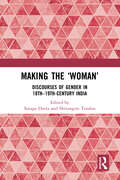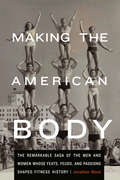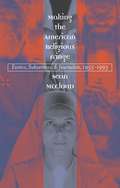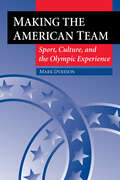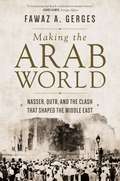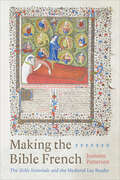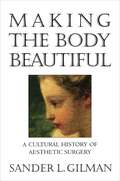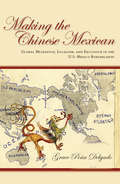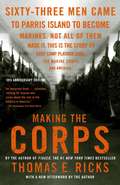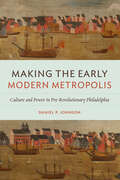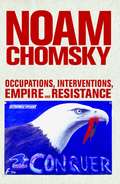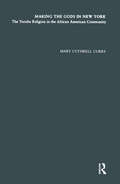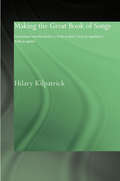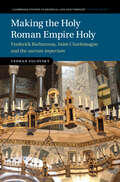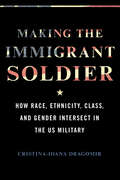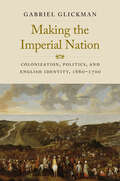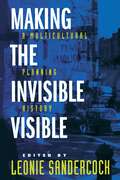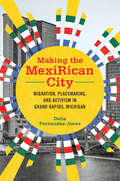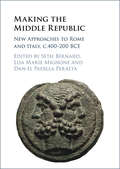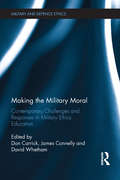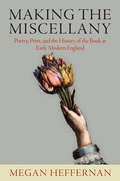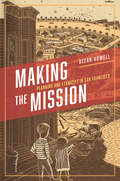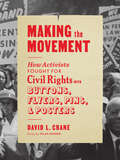- Table View
- List View
Making the 'Woman': Discourses of Gender in 18th-19th century India
by Sutapa Dutta Shivangini TandonThe book examines the representation of women, their agency and subjectivity and gender relations in 18th- and 19th-century India. The chapters in the volume interrogate notions and discourses of ‘women’ and ‘gender’ during the period, historically shaped by multiple and even competing actors, practices and institutions. They highlight the ‘making of the woman’ across a wide spectrum of subject areas, regions and roles and attempt to understand the contradictions and differences in social experiences and identity formations of women. The volume also deals with prevalent notions of masculinity and femininity, normative and non-conformist expressions of gender and sexual identity and epistemological concerns of gender, especially in its intersectional interplay with other axes of caste, class, race, region and empire. Presenting unique understandings of our gendered pasts, this volume will be of great interest to scholars and researchers of history, gender studies and South Asian studies.
Making the American Body: The Remarkable Saga of the Men and Women Whose Feats, Feuds, and Passions Shaped Fitness History
by Jonathan BlackIf you thought the fitness craze was about being healthy, think again. Although Charles Atlas, Jack LaLanne, Jim Fixx, Jane Fonda, Richard Simmons, and Jillian Michaels might well point the way to a better body, they have done so only if their brands brought in profits. In the first book to tell the full story of the American obsession with fitness and how we got to where we are today, Jonathan Black gives us a backstage look at an industry and the people that have left an indelible mark on the American body and the consciousness it houses. Spanning the nation&’s fitness obsession from Atlas to Arnold, from Spinning to Zumba, and featuring an outrageous cast of characters bent on whipping us into shape while simultaneously shaping the way we view our bodies, Black tells the story of an outsized but little-examined aspect of our culture. With insights drawn from more than fifty interviews and attention to key developments in bodybuilding, aerobics, equipment, health clubs, running, sports medicine, group exercise, Pilates, and yoga, Making the American Body reveals how a focus on fitness has shaped not only our physiques but also, and more profoundly, American ideas of what &“fitness&” is.
Making the American Religious Fringe
by Sean MccloudIn an examination of religion coverage in Time, Newsweek, Life, The Saturday Evening Post, Ebony, Christianity Today, National Review, and other news and special interest magazines, Sean McCloud combines religious history and social theory to analyze how and why mass-market magazines depicted religions as "mainstream" or "fringe" in the post-World War II United States. McCloud argues that in assuming an American mainstream that was white, middle class, and religiously liberal, journalists in the largest magazines, under the guise of objective reporting, offered a spiritual apologetics for the dominant social order. McCloud analyzes articles on a wide range of religious movements from the 1950s through the early 1990s, including Pentecostalism, the Nation of Islam, California cults, the Jesus movement, South Asian gurus, and occult spirituality. He shows that, in portraying certain beliefs as "fringe," magazines evoked long-standing debates in American religious history about emotional versus rational religion, exotic versus familiar spirituality, and normal versus abnormal levels of piety. He also traces the shifting line between mainstream and fringe, showing how such boundary shifts coincided with larger changes in society, culture, and the magazine industry. McCloud's astute analysis helps us understand both broad conceptions of religion in the United States and the role of mass media in American society.
Making the American Team: Sport, Culture, and the Olympic Experience (Sport and Society)
by Mark DyresonSport dominates television and the mass media. Politics and business are a-bustle with sports metaphors. Endorsements by athletes sell us products. "Home run," "slam dunk," and the rest of the vocabulary of sport color daily conversation. Even in times of crisis and emergency, the media reports the scores and highlights. Marky Dyreson delves into how our obsession with sport came into being with a close look at coverage of the Olympic Games between 1896 and 1912. How people reported and consumed information on the Olympics offers insight into how sport entered the heart of American culture as part of an impetus for social reform. Political leaders came to believe in the power of sport to revitalize the "republican experiment." Sport could instill a new sense of national identity that would forge a new sense of community and a healthy political order while at the same time linking America's intellectual and power elite with the experiences of the masses.
Making the Arab World: Nasser, Qutb, and the Clash That Shaped the Middle East
by Fawaz A. GergesHow the conflict between political Islamists and secular-leaning nationalists has shaped the history of the modern Middle EastIn 2013, just two years after the popular overthrow of Hosni Mubarak, the Egyptian military ousted the country’s first democratically elected president—Mohamed Morsi of the Muslim Brotherhood—and subsequently led a brutal repression of the Islamist group. These bloody events echoed an older political rift in Egypt and the Middle East: the splitting of nationalists and Islamists during the rule of Egyptian president and Arab nationalist leader Gamal Abdel Nasser. In Making the Arab World, Fawaz Gerges, one of the world’s leading authorities on the Middle East, tells how the clash between pan-Arab nationalism and pan-Islamism has shaped the history of the region from the 1920s to the present.Gerges tells this story through an unprecedented dual biography of Nasser and another of the twentieth-century Arab world’s most influential figures—Sayyid Qutb, a leading member of the Muslim Brotherhood and the father of many branches of radical political Islam. Their deeply intertwined lives embody and dramatize the divide between Arabism and Islamism. Yet, as Gerges shows, beyond the ideological and existential rhetoric, this is a struggle over the state, its role, and its power.Based on a decade of research, including in-depth interviews with many leading figures in the story, Making the Arab World is essential reading for anyone who wants to understand the roots of the turmoil engulfing the Middle East, from civil wars to the rise of Al-Qaeda and ISIS.
Making the Bible French: The Bible historiale and the Medieval Lay Reader
by Jeanette PattersonFrom the end of the thirteenth century to the first decades of the sixteenth century, Guyart des Moulins’s Bible historiale was the predominant French translation of the Bible. Enhancing his translation with techniques borrowed from scholastic study, vernacular preaching, and secular fiction, Guyart produced one of the most popular, most widely copied French-language texts of the later Middle Ages. Making the Bible French investigates how Guyart’s first-person authorial voice narrates translation choices in terms of anticipated reader reactions and frames the biblical text as an object of dialogue with his readers. It examines the translator’s narrative strategies to aid readers’ visualization of biblical stories, to encourage their identification with its characters, and to practice patient, self-reflexive reading. Finally, it traces how the Bible historiale manuscript tradition adapts and individualizes the Bible for each new intended reader, defying modern print-based and text-centred ideas about the Bible, canonicity, and translation.
Making the Body Beautiful: A Cultural History of Aesthetic Surgery
by Sander L. GilmanNose reconstructions have been common in India for centuries. South Korea, Brazil, and Israel have become international centers for procedures ranging from eyelid restructuring to buttock lifts and tummy tucks. Argentina has the highest rate of silicone implants in the world. Around the globe, aesthetic surgery has become a cultural and medical fixture. Sander Gilman seeks to explain why by presenting the first systematic world history and cultural theory of aesthetic surgery. Touching on subjects as diverse as getting a "nose job" as a sweet-sixteen birthday present and the removal of male breasts in seventh-century Alexandria, Gilman argues that aesthetic surgery has such universal appeal because it helps people to "pass," to be seen as a member of a group with which they want to or need to identify. Gilman begins by addressing basic questions about the history of aesthetic surgery. What surgical procedures have been performed? Which are considered aesthetic and why? Who are the patients? What is the place of aesthetic surgery in modern culture? He then turns his attention to that focus of countless human anxieties: the nose. Gilman discusses how people have reshaped their noses to repair the ravages of war and disease (principally syphilis), to match prevailing ideas of beauty, and to avoid association with negative images of the "Jew," the "Irish," the "Oriental," or the "Black." He examines how we have used aesthetic surgery on almost every conceivable part of the body to try to pass as younger, stronger, thinner, and more erotic. Gilman also explores some of the extremes of surgery as personal transformation, discussing transgender surgery, adult circumcision and foreskin restoration, the enhancement of dueling scars, and even a performance artist who had herself altered to resemble the Mona Lisa. The book draws on an extraordinary range of sources. Gilman is as comfortable discussing Nietzsche, Yeats, and Darwin as he is grisly medical details, Michael Jackson, and Barbra Streisand's decision to keep her own nose. The book contains dozens of arresting images of people before, during, and after surgery. This is a profound, provocative, and engaging study of how humans have sought to change their lives by transforming their bodies.
Making the Carry: The Lives of John and Tchi-Ki-Wis Linklater
by Timothy CochraneAn extraordinary illustrated biography of a Métis man and Anishinaabe woman navigating great changes in their homeland along the U.S.–Canada border in the early twentieth century John Linklater, of Anishinaabeg, Cree, and Scottish ancestry, and his wife, Tchi-Ki-Wis, of the Lac La Croix First Nation, lived in the canoe and border country of Ontario and Minnesota from the 1870s until the 1930s. During that time, the couple experienced radical upheavals in the Quetico–Superior region, including the cutting of white and red pine forests, the creation of Indian reserves/reservations and conservation areas, and the rise of towns, tourism, and mining. With broad geographical sweep, historical significance, and biographical depth, Making the Carry tells their story, overlooked for far too long.John Linklater, a renowned game warden and skilled woodsman, was also the bearer of traditional ecological knowledge and Indigenous heritage, both of which he was deeply committed to teaching others. He was sought by professors, newspaper reporters, museum personnel, and conservationists—among them Sigurd Olson, who considered Linklater a mentor. Tchi-Ki-Wis, an extraordinary craftswoman, made a sweeping array of necessary yet beautiful objects, from sled dog harnesses to moose calls to birch bark canoes. She was an expert weaver of large Anishinaabeg cedar bark mats with complicated geometric designs, a virtually lost art.Making the Carry traces the routes by which the couple came to live on Basswood Lake on the international border. John&’s Métis ancestors with deep Hudson&’s Bay Company roots originally came from Orkney Islands, Scotland, by way of Hudson Bay and Red River, or what is now Winnipeg. His family lived in Manitoba, northwest Ontario, northern Minnesota, and, in the case ofJohn and Tchi-Ki-Wis, on Isle Royale. A journey through little-known Canadian history, the book provides an intimate portrait of Métis people.Complete with rarely seen photographs of activities from dog mushing to guiding to lumbering, as well as of many objects made by Tchi-Ki-Wis, such as canoes, moccasins, and cedar mats, Making the Carry is a window on a traditional way of life and a restoration of two fascinating Indigenous people to their rightful place in our collective past.
Making the Chinese Mexican: Global Migration, Localism, and Exclusion in the U.S.-Mexico Borderlands
by Grace Peña DelgadoMaking the Chinese Mexicanis the first book to examine the Chinese diaspora in the U. S. -Mexico borderlands. It presents a fresh perspective on immigration, nationalism, and racism through the experiences of Chinese migrants in the region during the late nineteenth and early twentieth centuries. Navigating the interlocking global and local systems of migration that underlay Chinese borderlands communities, the author situates the often-paradoxical existence of these communities within the turbulence of exclusionary nationalisms. The world of Chinesefronterizos(borderlanders) was shaped by the convergence of trans-Pacific networks and local arrangements: against a backdrop of national unrest in Mexico and in the era of exclusionary immigration policies in the United States, Chinesefronterizoscarved out vibrant, enduring communities that provided a buffer against virulent Sinophobia. This book challenges us to reexamine the complexities of nation-making, identity formation, and the meaning of citizenship. It represents an essential contribution to our understanding of the U. S. -Mexico borderlands.
Making the Corps: 61 Men Came to Parris Island to Become Marines
by Thomas E. RicksThe United States Marine Corps, with its proud tradition of excellence in combat, its hallowed rituals, and its unbending code of honor, is part of the fabric of American myth. Making the Corps visits the front lines of boot camp in Parris Island, South Carolina. Here, old values are stripped away and new Marine Corps values are forged. Bestselling author Thomas E. Ricks follows these men from their hometowns, through boot camp and into their first year as Marines. As three fierce drill instructors fight a battle for the hearts and minds of this unforgettable group of young men, a larger picture emerges, brilliantly painted, of the growing gulf that divides the military from the rest of America. Included in this edition is an all-new afterword from the author that examines the war in Iraq through the lens of the Marines from Platoon 3086, giving readers an on-the-ground view of the conflict from those who know it best
Making the Early Modern Metropolis: Culture and Power in Pre-Revolutionary Philadelphia (Early American Histories)
by Daniel P. JohnsonPhiladelphia was the most dynamic city in seventeenth- and eighteenth-century British America. In Making the Early Modern Metropolis, Daniel Johnson takes a thematic approach to Philadelphia’s related economic, legal, and popular cultures to provide a comprehensive view of its urban development, taking readers into this colonial city’s homes, workshops, taverns, courtrooms, and public spaces to provide a detailed exploration of how everyday struggles shaped the city’s growth.Philadelphia’s evolution, Johnson argues, can only be understood by situating it within an explicitly early modern and Atlantic framework to show that inherited beliefs, which originated in late medieval and Renaissance Europe, informed urban social and cultural developments. Until now, histories of early Philadelphia, and Pennsylvania at large, have emphasized its novel commitment to liberal and modern religious, economic, and political principles. Making the Early Modern Metropolis reveals that it was in the interplay of inherited and often competing systems of belief during a period of profound transformation throughout the Atlantic world that early modern cities like Philadelphia were shaped.
Making the Future: Occupations, Interventions, Empire and Resistance
by Noam ChomskyMaking the Future presents more than fifty concise and persuasively argued commentaries on U.S. politics and policies, written between 2007 and 2011. Taken together, Chomsky's essays present a powerful counter-narrative to official accounts of the major political events of the past four years: the wars in Afghanistan and Iraq; the U.S. presidential race; the ascendancy of China; Latin America's leftward turn; the threat of nuclear proliferation in Iran and North Korea; Israel's invasion of Gaza and expansion of settlements in Jerusalem and the West Bank; developments in climate change; the world financial crisis; the Arab Spring; the assassination of Osama bin Laden; and the Occupy protests. Laced throughout his critiques are expressions of commitment to democracy and the power of popular struggles. "Progressive legislation and social welfare," writes Chomsky, "have been won by popular struggles, not gifts from above. Those struggles follow a cycle of success and setback. They must be waged every day, not just once every four years, always with the goal of creating a genuinely responsive democratic society, from the voting booth to the workplace." Making the Future is a follow-up to Interventions, published by City Lights in 2007 and banned from Guantánamo Bay by U.S. military censors. Both books are drawn from articles Chomsky has been writing regularly for the New York Times Syndicate, but which go largely ignored by newspapers in the United States. Making the Future offers fierce, accessible, timely, gloves-off political writing by one of America's foremost intellectual and political dissidents.
Making the Gods in New York: The Yoruba Religion in the African American Community (Studies in African American History and Culture)
by Mary Cuthrell CurryOver the last 35 years, practice of Santeria and the Yoruba religion in the United States has grown as the result of African American search for identity and large scale Cuban migration. While the ritual and belief systems of Santeria and the Yoruba Religion are essentially the same, the practical religion of both differs. Both center around questions of group identity and the concerns of their practitioners. This book focuses on the changes in the Yoruba Practical Religion of the Converted in the African American community. Through insighful attention to rich ethnographic detail, the author explores the beliefs, practices, and rituals of this religious community.
Making the Great Book of Songs: Compilation and the Author's Craft in Abû I-Faraj al-Isbahânî's Kitâb al-aghânî (Routledge Studies in Middle Eastern Literatures)
by Hilary KilpatrickThis is the first systematic literary study of one of the masterpieces of classical Arabic literature, the fourth/tenth century Kitâb al-aghânî (The Book of Songs) by Abû I-Faraj al-Isbahânî. Until now the twenty-four volume Book of Songs has been regarded as a rather chaotic but priceless mine of information about classical Arabic music, literature and culture. This book approaches it as a work of literature in its own right, with its own internal logic and coherence. The study also consistently integrates the musical component into the analysis and proposes a reading of the work in which individual anecdotes and poems are related to the wider context, enhancing their meaning.
Making the Holy Roman Empire Holy: Frederick Barbarossa, Saint Charlemagne and the sacrum imperium (Cambridge Studies in Medieval Life and Thought: Fourth Series)
by Vedran SulovskyHow did the Holy Roman Empire (sacrum imperium) become Holy? In this innovative book, Vedran Sulovsky explores the reign of Frederick Barbarossa (1152–1190), offering a new analysis of the key documents, artworks, and contemporary scholarship used to celebrate and commemorate the imperial regime, especially in the imperial coronation site and Charlemagne's mausoleum, the Marienkirche in Aachen. By dismantling the Kulturkampf-inspired view of the history of the Holy Roman Empire – which was supposedly desacralised in the Investiture Controversy, and then resacralised by Barbarossa and the Reichskanzler Rainald of Dassel – Sulovsky, using new evidence, reveals the personal relations between various courtiers which led to the rise of the new, holy name of the Empire. Annals, chronicles, charters, forgeries, letters, liturgical texts and objects, relics, insignia, seals, architecture and rituals have all been exploited by Sulovsky to piece together a mosaic that shows the true roots of sacrum imperium.
Making the Immigrant Soldier: How Race, Ethnicity, Class, and Gender Intersect in the US Military
by Cristina-Ioana DragomirImmigrants to the United States have long used the armed forces as a shortcut to citizenship. Cristina-Ioana Dragomir profiles Lily, Alexa, and Vikrant, three immigrants of varying nationalities and backgrounds who chose military service as their way of becoming American citizens. Privileging the trio’s own words and experiences, Dragomir crafts a human-focused narrative that moves from their lives in their home countries and decisions to join the military to their fraught naturalization processes within the service. Dragomir illuminates how race, ethnicity, class, and gender impacted their transformation from immigrant to soldier, veteran, and American. She explores how these factors both eased their journeys and created obstacles that complicated their access to healthcare, education, economic resources, and other forms of social justice. A compelling union of analysis and rich storytelling, Making the Immigrant Soldier traces the complexities of serving in the military in order to pursue the American dream.
Making the Imperial Nation: Colonization, Politics, and English Identity, 1660-1700 (The Lewis Walpole Series in Eighteenth-Century Culture and History)
by Gabriel GlickmanHow did the creation of an overseas empire change politics in England itself? After 1660, English governments aimed to convert scattered overseas dominions into a coordinated territorial power base. Stuart monarchs encouraged schemes for expansion in America, Africa, and Asia, tightened control over existing territories, and endorsed systems of slave labor to boost colonial prosperity. But English power was precarious, and colonial designs were subject to regular defeats and failed experimentation. Recovering from recent Civil Wars at home, England itself was shaken by unrest and upheaval through the later seventeenth century. Colonial policies emerged from a kingdom riven with inner tensions, which it exported to enclaves overseas. Gabriel Glickman reinstates the colonies within the domestic history of Restoration England. He shows how the pursuit of empire raised moral and ideological controversies that divided political opinion and unsettled many received ideas of English national identity. Overseas ambitions disrupted bonds in Europe and cast new questions about English relations with Scotland and Ireland. Vigorous debates were provoked by contact with non-Christian peoples and by changes brought to cultural tastes and consumer habits at home. England was becoming an imperial nation before it had acquired a secure territorial empire. The pressures of colonization exerted a decisive influence over the wars, revolutions, and party conflicts that destabilized the later Stuart kingdom.
Making the Invisible Visible: A Multicultural Planning History (California Studies in Critical Human Geography #2)
by Leonie SandercockThe history of planning is much more, according to these authors, than the recorded progress of planning as a discipline and a profession. These essays counter the mainstream narrative of rational, scientific development with alternative histories that reveal hitherto invisible planning practices and agendas. While the official story of planning celebrates the state and its traditions of city building and regional development, these stories focus on previously unacknowledged actors and the noir side of planning.Through a variety of critical lenses—feminist, postmodern, and postcolonial—the essays examine a broad range of histories relevant to the preservation and planning professions. Some contributors uncover indigenous planning traditions that have been erased from the record: African American and Native American traditions, for example. Other contributors explore new themes: themes of gendered spaces and racist practices, of planning as an ordering tool, a kind of spatial police, of "bodies, cities, and social order" (influenced by Foucault, Lefebvre, and others), and of resistance.This scrutiny of the class, race, gender, ethnic, or ideological biases of ideas and practices inherent in the notion of planning as a modernist social technology clearly points to the inadequacy of modernist planning histories. Making the Invisible Visible redefines planning as the regulation of the physicality, sociality, and spatiality of the city. Its histories provide the foundation of a new, alternative planning paradigm for the multicultural cities of the future.
Making the Market: Victorian Origins of Corporate Capitalism
by Paul JohnsonCorporate capitalism was invented in nineteenth-century Britain; most of the market institutions that we take for granted today - limited companies, shares, stock markets, accountants, financial newspapers - were Victorian creations. So were the moral codes, the behavioural assumptions, the rules of thumb and the unspoken agreements that made this market structure work. This innovative study provides the first integrated analysis of the origin of these formative capitalist institutions, and reveals why they were conceived and how they were constructed. It explores the moral, economic and legal assumptions that supported this formal institutional structure, and which continue to shape the corporate economy of today. Tracing the institutional growth of the corporate economy in Victorian Britain and demonstrating that many of the perceived problems of modern capitalism - financial fraud, reckless speculation, excessive remuneration - have clear historical precedents, this is a major contribution to the economic history of modern Britain.
Making the MexiRican City: Migration, Placemaking, and Activism in Grand Rapids, Michigan (Latinos in Chicago and Midwest)
by Delia Fernández-JonesLarge numbers of Latino migrants began to arrive in Grand Rapids, Michigan, in the 1950s. They joined a small but established Spanish-speaking community of people from Texas, Mexico, and Puerto Rico. Delia Fernández-Jones merges storytelling with historical analysis to recapture the placemaking practices that these Mexicans, Tejanos, and Puerto Ricans used to create a new home for themselves. Faced with entrenched white racism and hostility, Latinos of different backgrounds formed powerful relationships to better secure material needs like houses and jobs and to recreate community cultural practices. Their pan-Latino solidarity crossed ethnic and racial boundaries and shaped activist efforts that emphasized working within the system to advocate for social change. In time, this interethnic Latino alliance exploited cracks in both overt and structural racism and attracted white and Black partners to fight for equality in social welfare programs, policing, and education. Groundbreaking and revelatory, Making the MexiRican City details how disparate Latino communities came together to respond to social, racial, and economic challenges.
Making the Middle Republic: New Approaches to Rome and Italy, c.400-200 BCE
by Seth Bernard Lisa Marie Mignone Peralta, Dan-el PadillaDuring the fourth and third centuries BCE, Roman expansion into Italy reshaped the peninsula's Archaic societies and prompted new political relationships, new economic practices, and new sociocultural structures. Rural landscapes and urban spaces throughout Latium saw intensified use amidst novel principles of land management, animal husbandry, and architectural design. This book offers fresh perspectives on these transformations by embracing a wide range of approaches to Middle Republican history. Chapters take up topics and methods ranging from fiscal sociology, bioarchaeology, comparative slaveries, field survey, art and architectural history, numismatics, elite mobility, and beyond. An emphasis is placed on how developments in this period reshaped not only Rome, but also other Latin and Italian societies in complex and often multilinear ways. The volume promotes the Middle Republic as a period whose full dynamism is best appreciated at the intersection of diverse lines of inquiry.
Making the Military Moral: Contemporary Challenges and Responses in Military Ethics Education (Military and Defence Ethics)
by Don Carrick, James Connelly and David WhethamThis book offers a critical analysis, both theoretical and practical, of ethics education in the military. In the twenty-first century, it has become increasingly important to ensure that the armed forces of Western and other democracies fight justly and behave ethically. The ‘good soldier’ has to be not only professionally skilled but morally intelligent. At a time of relentless media scrutiny, the publicising of incidents of morally and legally unacceptable behaviour, such as the gross mistreatment of prisoners and the torture of suspected terrorists, can do much to undermine the credibility of those who claim to hold the moral high ground in any particular conflict. Written by an international team of academic theorists and military practitioners, this volume provides inter-disciplinary insights into the present state, and the future, of ethics education in the militaries of Western democracies. The contributors critically address the central question of whether such education is sufficient to prepare members of the armed forces to face the peculiar challenges of conflict environments that are now primarily ‘wars among the people’, in which the opposing combatants may have little or no regard for human life and fail to discriminate between soldiers and civilians when choosing their targets. Drawing lessons from recent examples of unethical conduct, this original book offers insightful and constructive advice, both theoretical and practical, as to how situations can be improved and on the means that could and should be employed towards this end. This book will be of much interest to students of military studies, ethics and international relations.
Making the Miscellany: Poetry, Print, and the History of the Book in Early Modern England
by Megan HeffernanIn Making the Miscellany Megan Heffernan examines the poetic design of early modern printed books and explores how volumes of compiled poems, which have always existed in practice, responded to media change in sixteenth- and seventeenth-century England. Heffernan's focus is not only the material organization of printed poetry, but also how those conventions and innovations of arrangement contributed to vernacular poetic craft, the consolidation of ideals of individual authorship, and centuries of literary history.The arrangement of printed compilations contains a largely unstudied and undertheorized archive of poetic form, Heffernan argues. In an evolving system of textual transmission, compilers were experimenting with how to contain individual poems within larger volumes. By paying attention to how they navigated and shaped the exchanges between poems and their organization, she reveals how we can witness the basic power of imaginative writing over the material text.Making the Miscellany is also a study of how this history of textual design has been differently told by the distinct disciplines of bibliography or book history and literary studies, each of which has handled—and obscured—the formal qualities of early modern poetry compilations and the practices that produced them. Revisiting these editorial and critical approaches, this book recovers a moment when compilers, poets, and readers were alert to a poetics of organization that exceeded the limits of the individual poem.
Making the Mission: Planning and Ethnicity in San Francisco
by Ocean HowellIn the aftermath of the 1906 San Francisco earthquake, residents of the city's iconic Mission District bucked the city-wide development plan, defiantly announcing that in their neighborhood, they would be calling the shots. Ever since, the Mission has become known as a city within a city, and a place where residents have, over the last century, organized and reorganized themselves to make the neighborhood in their own image. In Making the Mission, Ocean Howell tells the story of how residents of the Mission District organized to claim the right to plan their own neighborhood and how they mobilized a politics of place and ethnicity to create a strong, often racialized identity--a pattern that would repeat itself again and again throughout the twentieth century. Surveying the perspectives of formal and informal groups, city officials and district residents, local and federal agencies, Howell articulates how these actors worked with and against one another to establish the very ideas of the public and the public interest, as well as to negotiate and renegotiate what the neighborhood wanted. In the process, he shows that national narratives about how cities grow and change are fundamentally insufficient; everything is always shaped by local actors and concerns.
Making the Movement: How Activists Fought for Civil Rights with Buttons, Flyers, Pins, and Posters
by David L. CranePacked with over 200 color photos, this visual journey through Black history and the Civil Rights Movement is told through the objects—buttons, badges, flyers, pennants, posters, and more—designed by activists as tools to advance the fight for justice and freedom, offering a unique perspective on the Civil Rights Movement from Emancipation through the present day. From Reconstruction through Jim Crow, through the protest era of the 1960s and '70s, to current-day resistance and activism such as the Black Lives Matter movement, the material culture of the Civil Rights Movement has been integral to its goals and tactics. During decades of sit-ins, marches, legal challenges, political campaigns, boycotts, and demonstrations, objects such as buttons, flyers, pins, and posters have been key in the fight against racism, oppression, and violence. Making the Movement presents more than 200 of these nonviolent weapons alongside the stories of the activists, organizations, and campaigns that defined and propelled the cause of civil rights. It is a must-read for anyone seeking to learn about Black and African American history in the United States and about strategies to combat racism and the structures that support it.
